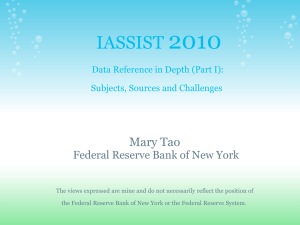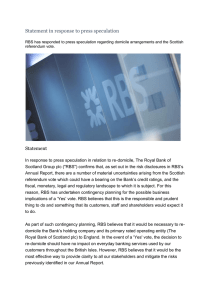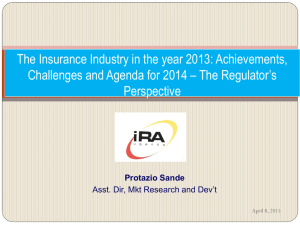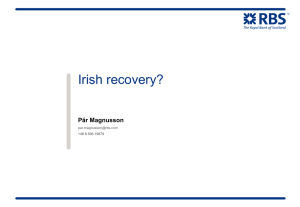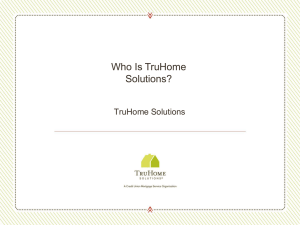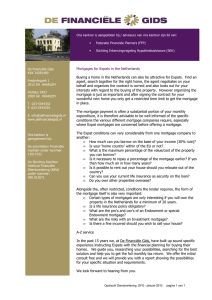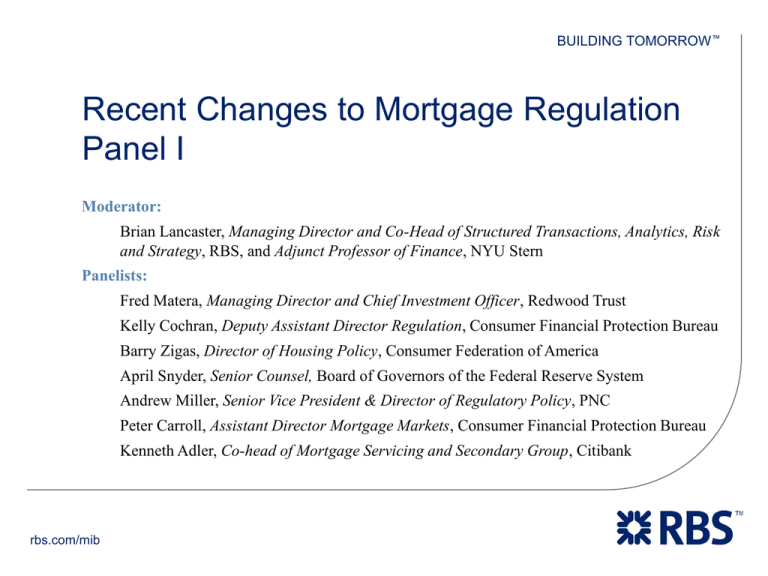
BUILDING TOMORROW ™
Recent Changes to Mortgage Regulation
Panel I
Moderator:
Brian Lancaster, Managing Director and Co-Head of Structured Transactions, Analytics, Risk
and Strategy, RBS, and Adjunct Professor of Finance, NYU Stern
Panelists:
Fred Matera, Managing Director and Chief Investment Officer, Redwood Trust
Kelly Cochran, Deputy Assistant Director Regulation, Consumer Financial Protection Bureau
Barry Zigas, Director of Housing Policy, Consumer Federation of America
April Snyder, Senior Counsel, Board of Governors of the Federal Reserve System
Andrew Miller, Senior Vice President & Director of Regulatory Policy, PNC
Peter Carroll, Assistant Director Mortgage Markets, Consumer Financial Protection Bureau
Kenneth Adler, Co-head of Mortgage Servicing and Secondary Group, Citibank
rbs.com/mib
BUILDING TOMORROW ™
A. Recent Activity in the Private Label Market
Brian P. Lancaster
Managing Director, Co-Head of Structured Transactions Analytics Risk and Strategy
RBS
Adjunct Professor of Finance
NYU Stern
Fred Matera
Managing Director and Chief Investment Officer
Redwood Trust
rbs.com/mib
Non-Agency RMBS Annual Issuance
10
1,000
9
Total New Issuance ($bn)
1,100
Total New Issuance ($bn)
900
800
700
600
500
8
7
6
5
4
3
2
400
1
300
0
2008
200
2009
2010
2011
2012
100
0
ALT-A
2001
2002
2003
2004
2005
2006
SUBPRIME 2ND LIEN PRIME OPTARM OTHER
2007
2008
2009
2010
2011
2012
From an historic perspective non-agency RMBS issuance for the last few years has been anemic.
At the peak of the market some $1 trillion of private label MBS was issued. In 2011 less than $2 billion was issued.
Last year only about $6 billion was issued.
For 2013 we expect about 2 deals per month on average for about a $12 billion - $13 billion pace. Some market participants
expect more.
3
Recent Private Label RMBS Issuance
Most of these deals have
been collateralized by high
quality, prime jumbo
collateral (Sequoia and
Credit Suisse deals) and
about one third backed by
legacy subprime mortgages.
In addition there have been a
number of unrated nonperforming loan
securitizations (NPLs).
Most of the deals are backed
by fixed rate mortgages
although a few have been
backed by hybrid ARMs.
•In 2011, seven deals were
issued by 5 issuers totaling
$1.7 billion.
•In 2012, there were 15
deals worth $6.2 billion.
•2013 is running at about a
$13 billion annualized pace
with several new entrants,
such as JP Morgan.
Date
2/25/2011
4/29/2011
5/24/2011
8/24/2011
8/31/2011
9/16/2011
11/21/2011
1/25/2012
3/28/2012
3/29/2012
4/11/2012
6/21/2012
6/26/2012
6/26/2012
8/2/2012
9/20/2012
10/17/2012
10/18/2012
11/9/2012
11/27/2012
11/30/2012
12/6/2012
Issuer
Sequoia Mortgage Trust
Newcastle Investment Trust
Bank of America Funding Trust
Bank of America Funding Trust
Springleaf Mortgage Loan Trust
Sequoia Mortgage Trust
Bayview Opportunity Master Fund
REMIC Trust
2011 TOTAL
Series
Amt (mm)
2011-1
$295.44
2011-MH1
$171.41
2011-SD1
$43.62
2011-R3
$178.48
2011-1
$496.86
2011-2
$375.23
2011-A
$139.14
7
$1,700.18
Sequoia Mortgage Trust
Sequoia Mortgage Trust
CSMC Trust (Credit Suisse)
Springleaf Mortgage Loan Trust
WIMC Capital Trust
CSMC Trust (Credit Suisse)
Sequoia Mortgage Trust
Springleaf Mortgage Loan Trust
Sequoia Mortgage Trust
Sequoia Mortgage Trust
Springleaf Mortgage Loan Trust
CSMC Trust (Credit Suisse)
Sequoia Mortgage Trust
CSMC Trust (Credit Suisse)
Station Place Securitization Trust
2012 TOTAL
2012-1
2012-2
2012-CIM1
2012-1
2012-A
2012-CIM2
2012-3
2012-2
2012-4
2012-5
2012-3
2012-9
2012-6
2012-CIM3
2012-1
15
$415.73
$327.93
$741.94
$473.01
$102.00
$425.09
$293.59
$970.03
$313.23
$296.95
$1,030.57
$115.15
$301.46
$329.89
$60.00
$6,196.56
1/14/2013 Sequoia Mortgage Trust
2013-1
1/28/2013 Sequoia Mortgage Trust
2013-2
2013 TOTAL
2
Source: RBS, Asset Backed Alert
4
Type
Residential mortgages (includes Alt-A)
Manufactured housing loans
Subprime mortgages
Residential mortgages (includes Alt-A)
Subprime mortgages
Residential mortgages (includes Alt-A)
Subprime mortgages
Residential mortgages (includes Alt-A)
Residential mortgages (includes Alt-A)
Residential mortgages (includes Alt-A)
Subprime mortgages
Manufactured housing loans
Residential mortgages (includes Alt-A)
Residential mortgages (includes Alt-A)
Subprime mortgages
Residential mortgages (includes Alt-A)
Residential mortgages (includes Alt-A)
Subprime mortgages
Residential mortgages (includes Alt-A)
Residential mortgages (includes Alt-A)
Residential mortgages (includes Alt-A)
Residential mortgages (includes Alt-A)
$397.88 Residential mortgages (includes Alt-A)
$666.13 Residential mortgages (includes Alt-A)
$12,768.07 (annualized)
Issuer Motivations
Term Match Funding
By issuing jumbo prime deals and retaining nearly all of the bond classes except the AAA
rated classes issuers, such as Redwood, can add leverage and finance their mortgages thru
better duration matched, term funding, reducing many of the issues associated with the carry
trade which was discussed in the Mortgage REIT discussions this morning.
Lower Financing Costs
Springleaf can achieve a lower cost of financing than by issuing corporate debt.
5
Investors in Recent Private Label RMBS
AAA Jumbo Prime MBS Investors
AAA Subprime MBS Investors
Insurance Hedge
Companies Funds
5%
10%
Money Managers
25%
Banks
43%
Insurance Companies
10%
Money Managers
42%
Banks
65%
Source: RBS
• Banks and money managers account for the majority of investors in AAA jumbo prime MBS (90%) and
AAA Springleaf bonds (85%).
• Lower rated, higher yielding Springleaf bonds are mostly purchased by hedge funds and money
managers.
6
Investor Motivation in Buying Private Label RMBS
(bln)
2009
2010
2011
2012
2013
Treasury
1,475
1,591
1,075
1,100
1005
Agency
-12
-116
-201
-200
-123
Agency MBS
445
-108
160
65
76
IG Corporate
239
286
233
110
370
Total
2,147
1,653
1,267
1,075
1,328
Fed Purchases
1,598
293
434
143
1020*
549
1,360
833
932
308
Net of Fed
Source: RBS
Fed QE3 has been suppressing yields and reducing available bonds to investors.
In 2013, NET supply available to the market may be close to zero.
*We assume in January 2013 the Fed continues long Treasury purchases of $45bn a month, and continues $40bn a month in Agency MBS purchases through year end. We
believe it will take at least that long for the Fed to see a “sustainable” recovery.
7
Investor Motivation in Buying Private Label RMBS
Case-Shiller Home Price Index Quarterly Data (Not Seasonally Adjusted)
200
180
160
140
120
100
80
1998
1999
2000
2001
Source: Case Shiller, Bloomberg
2002
2003
2004
2005
2006
2007
2008
2009
2010
2011
2012
2013
Comfort with the underwriting of high quality collateral and stable to increasing house prices
make the sector more attractive to investors.
8
Further Growth of the Private Label RMBS Market: Impediments
and Requirements
Shrinking the Role of the US Government (GSEs) in Housing Finance
Currently Fannie Mae, Freddie Mac and FHA/VA account for about 90% of all mortgage originations as they
enjoy a financing advantage over the private sector because of their quasi government status. Reducing
conforming loan limits from a range of $417,000 to $625,000 would create more collateral for private sector
securitization.
The Federal Reserve’s agency MBS purchase program (QE3) while reducing overall supply and stimulating
investor demand for private label RMBS, also increases agency MBS prices which limits the growth of
private label securitization.
Balance sheet lenders, such as banks, finance mortgages with FDIC deposits have a funding advantage
versus private securitizations.
Agency MBS are exempt from Dodd Frank requirements, such as risk retention.
9
Further Growth of the Private Label Market: “G Fees”
A History of Rising G-fees
3/2008
Average Estimated Single-Family Guarantee Fees
Increase Upfront G-fees
80
Introduce Adverse Market Delivery Charge of 25bps
(upfront)
70
Introduce additional upfront fees based on FICO,
LTV and other risk factors
Housing and Economic Recovery Act (HERA)
requires the FHFA to conduct ongoing study of the
G-fees charged by FNM and FRE and to submit
annual reports to Congress
60
50
bps
7/30/2008
40
FRE Post Settlement Delivery fees increase 2550bps (larger increase for worse credit)
30
effective 4/2011
FNM LLPAs increase 25-50bps (larger increase for
worse credit)
20
10/2011
effective 1/2012
12/2011
effective 4/2012
8/31/2012
effective 1/2013
HARP 2.0 Reduced upfront G-fees, capped at 2.0%
for 30yr loans, waived for shorter terms
10
Temporary payroll Tax Cut Continuation Act of 2011
requires GSEs to raise annual G-fees by 10bps.
0
effective 3/2011
Annual G-fees increase on Average 10bps (less for
shorter terms)
2007
Upfront*
2008
2009
2010
2011
2012 (e)
2013 (e)
Ongoing
Source: FHFA, RBS. 2012-2013 estimates provided by RBS
Need for further increase in GSE guarantee fees (“G” fees) to make private securitization more competitive.
The GSEs have raised “G fees”. At the end of 2012 we estimate they were approximately in the low 50s.
If G-fees rise another 15bp to 20 bps, to 70s area, private label RMBS securitization will be competitive with
the GSEs.
We expect G-fees to rise another 20 bps to 70s by the end of 2013 which could result in significant growth in
private label RMBS issuance, all else equal.
10
Further Growth of the Private Label Market: Clarification of Private
Label MBS Regulations
Risk Retention
Premium Capture Reserve Account
US Regulators interpretation and implementation of Basel III (Simple Supervisory Formula Approach)
QM
Qualified Residential Mortgage (QRM)
Mortgage Servicing
11
Further Growth of the Private Label Market: Clarification of Private
Label MBS Regulations – Risk Retention/PCCRA
Premium capture reserve account is being taken “off the table”.
5% risk retention expected to proceed. But for how long, 3 years, 5 years, life of deal?
12
Further Growth of the Private Label Market: Clarification of Private
Label MBS Regulations - QM
Definition of Qualified Mortgage (QM): A qualified mortgage is a mortgage that meets the “Ability to Pay”
requirements of the Truth in Lending Act. A mortgage that meets this definition would provide protection to
issuer from borrower lawsuits (by providing either safe harbor or rebuttable presumption)
Qualified Residential Mortgage (QRM): Mortgages that can be securitized without risk retention on the
part of issuer.
To the extent QRM equals or is nearly equal to QM this will likely increase the amount of collateral available
for private label RMBS issuance if these terms are not too narrowly defined.
13
Further Growth of the Private Label Market: Clarification of Private
Label MBS Regulations - QM
Qualified Mortgage (QM) definition as currently proposed:
Qualified Mortgage: loans must have standardized features including periodic payments that are
substantially equal, except for the payment changes on an ARM. Upfront points cannot be more than 3%.
Loan must have back end debt to income (DTI) ≤ 43% or be eligible for agency execution.
Safe Harbor: Mortgage rate is ≤ 1.5% above prime mortgage rate
Rebuttable Presumption: (borrower is presumed to have the ability to pay but retains the ability to argue
this): Mortgage rate > 1.5% above prime mortgage rate
14
Further Growth of the Private Label Market: Clarification of Private
Label MBS Regulations
Non-Qualified Mortgages
Interest only mortgages
Loans with balloon payments
Negative amortization loans (e.g. option ARMs)
No income or asset verification loans
Loans with upfront fees > 3%, higher fees permitted for smaller loans
Loan amount
Cap on fees
$100,000
3%
$60,000 - $99,999
$3,000
$20,000 - $ $59,999
5%
$12,500 - $$19,999
$1,000
Less than $12,000
8%
15
Further Growth of the Private Label Market: Clarification of Private
Label MBS Regulations
Research literature estimates that majority of mortgages (85% to 90%) originated after 2010 would meet
qualified mortgage definition however 75% of mortgages originated before 2010 might be non-QM.
Concern that few non-QM mortgages would be originated as lenders face legal action from borrowers for the
first three years after origination or at any time during the foreclosure process. The financial damage
facing lenders with non-QM loans would be up to three years of mortgage costs.
16
Further Growth of the Private Label Market: Clarification of Private
Label MBS Regulations - QRM
The definition of Qualified Residential Mortgage (QRM) is currently being debated by six Federal regulators,
the Federal Reserve, HUD, FHFA, SEC, FDIC, and the OCC. Indeed, Bernanke mentioned it in his
testimony, “QRM should not be so constraining”.
Senator Corker has written a letter saying QRM should equal QM and the Mortgage Bankers Association is
working with Senators Landrieu, Hagan, and Isaksen (authors of the original QRM in Dodd-Frank) on the
definition of QRM.
To the extent QRM equals or is nearly equal to QM, this will likely increase the amount of private label
RMBS issuance.
17
The US Private Label MBS Market seems poised for significant
growth towards the end of this year or early next year depending on:
When “G-fees” are raised another 15 bps to 20 bps (expected towards the end of 2013).
If QRM definition is the same as or close to the definition of QM
How large an investor base is available to purchase bonds at or near current spreads
Other factors that could stimulate/hinder its further growth:
Reduction in maximum loan amounts guaranteed by the GSEs: mortgage servicing definition; Basel III/SSFA
risk weights for US securitized products, less Federal Reserve buying of Agency MBS.
Other issues?
18
Invitation to Consider a Derivatives Transaction: This communication is prepared by the sales and trading desk and is marketing material and/or trader commentary. It is not a product of the research department.
This material constitutes an invitation to consider entering into a derivatives transaction under U.S. CFTC Regulations §§ 1.71 and 23.605, where applicable, but is not a binding offer to buy/sell any financial
instrument. The views of the author may differ from others at The Royal Bank of Scotland plc, The Royal Bank of Scotland N.V. and/or RBS Securities Inc. (collectively "RBS").
Copyright ©2013 RBS Securities Inc. All rights reserved. RBS Securities Inc. member FINRA (http://www.finra.org) / SIPC (http://www.sipc.org), is a subsidiary of The Royal Bank of Scotland plc. RBS is the
marketing name for the securities business of RBS Securities Inc.
The author of this material is an economist, desk strategist, salesperson or trader and will be compensated based in part on the author’s own performance, the firm’s performance and the performance of the sales or
trading desk for which the author works. This material is informational only. It is not considered research and is not a product of any research department. RBS Securities Inc. is not, by making this material
available, providing investment, legal, tax, financial, accounting or other advice to you or any other party. RBS Securities Inc. is not acting as an advisor or fiduciary in any respect in connection with providing this
information, and no information or material contained herein is to be construed as either projections or predictions. Past performance is not indicative of future results. RBS Securities Inc. transacts business with
counterparties on an arm’s length basis and on the basis that each counterparty is sophisticated and capable of independently evaluating the merits and risks of each transaction and that each counterparty is making
an independent decision regarding any transaction. Counterparties must make their own independent decisions regarding any securities, financial instruments or strategies mentioned herein. This material is intended
for institutional investors only and should not be forwarded to third parties.
RBS Securities Inc., its affiliates, and/or any of their respective employees, clients and officers, including persons involved in the preparation or issuance of this material, act as a market maker for or deal as principal
in the financial instruments mentioned and may have a long or short position in, or engaged in transactions in, these financial instruments. As part of the sales or trading desk, the author may have consulted with the
trading desk while preparing this material and the trading desk may have accumulated positions in the financial instruments or related derivatives products that are the subject of this material. Accordingly, information
included in or excluded from this material is not independent from the proprietary interests of RBS Securities Inc., which may conflict with your interests.
Except as to securities issued by the U.S. government and debentures issued by government-sponsored enterprises, RBS Securities Inc. does not permit the author of this material to hold, or engage in transactions
in, the securities or other financial instruments discussed herein in any personal account of the author or a member of the author’s household.
Certain transactions, including those involving futures, options, derivatives and high yield securities, give rise to substantial risk and are not suitable for all investors. Foreign currency denominated securities are
subject to fluctuations in exchange rates that could have an adverse effect on the value or price of or income derived from any investments discussed herein. In addition, investors in securities such as ADRs, the
values of which are influenced by foreign currencies, effectively assume currency risk. Please ensure that you have read and understood the current options disclosure document before entering into any options
transactions. United States listed options disclosure documents are available from our sales representatives or at http://www.theocc.com/components/docs/riskstoc.pdf. Unless otherwise specifically stated, all
statements contained herein (including any views, opinions or forecasts) are as of the date indicated only, and are subject to change without notice. Changes to assumptions made in the preparation of such material
may have a material impact on returns. RBS Securities Inc. does not undertake a duty to update this material or to notify you when or whether the analysis has changed. While the information contained in this
material is believed to be reliable, no representation or warranty, whether express or implied, is made and no liability or responsibility is accepted by RBS Securities Inc. or its affiliates as to the accuracy or
completeness thereof, except with respect to any disclosures relative to RBS Securities Inc. and/or its affiliates and the author’s involvement with an issuer that is the subject of this material.
RBS Securities Inc. makes no representations that this material or any information contained herein are appropriate for use in all locations or that transactions, securities, products, instruments or services discussed
herein are available or appropriate for sale or use in all jurisdictions, or by all investors or counterparties. Investors who receive this material may not necessarily be able to deal directly with RBS Securities Inc. and
should contact the RBS Securities Inc. entity or affiliate in their home jurisdiction unless governing law permits otherwise. Those who utilize this information do so on their own initiative and are responsible for
compliance with applicable local laws or regulations.
This material is made available in the European Economic Area ("EEA") by The Royal Bank of Scotland plc, which is authorized and regulated by the Financial Services Authority (FSA). RBS Securities Inc. distributes
this material in the U.S. With respect to the execution of interest rate derivatives, credit derivatives and foreign exchange transactions, RBS Securities Inc. generally acts as agent for RBS which will be the principal in
such transactions.
This website and its contents have not been reviewed by any regulatory authority in Hong Kong. RBS Securities Inc. does not conduct, nor holds itself out as conducting a business in investment advisory or dealing
services in Hong Kong, nor any other regulated activity. It holds no Hong Kong regulatory licenses.
This material is distributed in Singapore by The Royal Bank of Scotland plc (Singapore branch), Level 26, One Raffles Quay, south Tower, Singapore 048583, which is regulated by the Monetary Authority of
Singapore. In Singapore, this material is intended solely for distribution to institutional investors, accredited investors, and expert investors as defined under the (Singapore) Financial Advisers Act, Chapter 110.
Persons receiving this material in Singapore should contact The Royal Bank of Scotland plc (Singapore branch) in respect of any matters in connection with the material.)
Both RBS Tokyo and RBSSJ are regulated by Japanese Financial Services Agency. This Material is provided for information only and it does not constitute an offer or a solicitation to deal in any specific products or to
enter into any legal relations, nor an advice or a recommendation with respect to such products. Clients should independently evaluate particular investments before dealing in any products herein referred to.
Persons obtaining this information through RBSM website are limited to Professional Investors (as defined in Article 2-31 of Financial Instruments and Exchange Law) only. The access to the website is provided by
RBS Tokyo Branch (RBS Tokyo) or RBS Securities Japan Limited (RBSSJ) to their respective Clients in Japan who are classified as Professional Investors. However some Material is intended to be provided only to
Qualified Institutional Investors (as defined in Article 10 of Cabinet Office Ordinance concerning Definitions provided in Article 2 of Financial Instruments and Exchange Law).
RBS Securities Inc. is exempt from the requirement to hold an Australian Financial Services License under the Corporations Act 2001 of Australia in respect of these financial services, and that RBS is regulated by
the SEC under US laws, which differ from Australian laws.
The views expressed in this publication accurately reflect the author’s personal views about the subject financial instruments and issuers, and no part of the author’s compensation was, is, or will be directly or
indirectly related to the specific recommendations or views contained herein.
19

